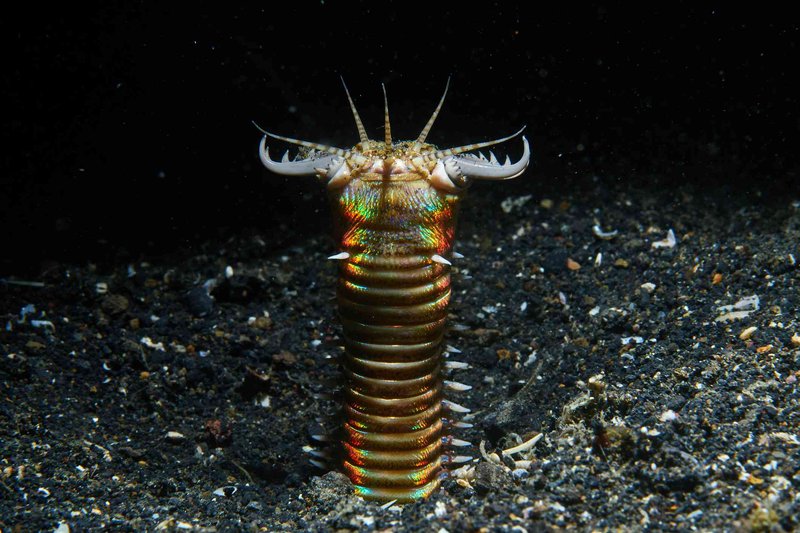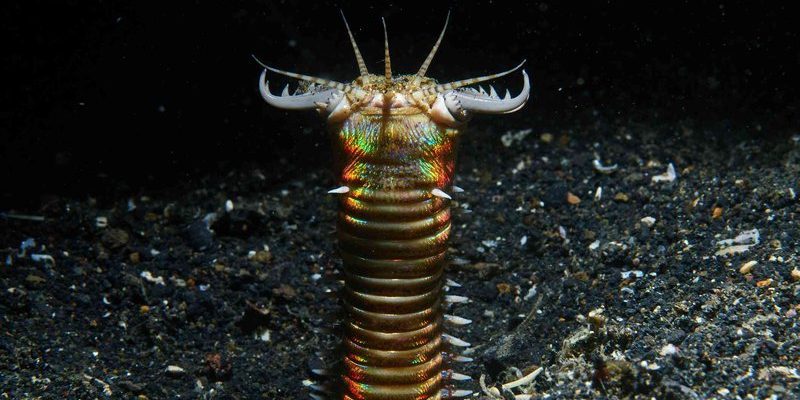
The Anatomy of a Bobbit Worm
To better understand the bite force of the bobbit worm, it’s helpful to first look at its anatomy. At the heart of its predatory skills is the worm’s mouth, which is equipped with specialized jaws. Unlike many sea creatures, the bobbit worm uses a unique approach to catch its food, employing a strategy that combines stealth and sudden force.
The jaws of a bobbit worm are not your typical mouthparts. They have evolved to be sharp and powerful, much like scissor blades. These jaws are built for grabbing and cutting through the soft bodies of fish and crustaceans. When the worm senses potential prey, it can launch out of its burrow with impressive speed, using its jaws to snatch its dinner in the blink of an eye. It’s like a high-speed ambush predator that you might see in a nature documentary!
Jaw Structure and Material
The composition of a bobbit worm’s jaw is made of a tough, chitinous material, which is common among many invertebrates. Chitin is a strong, flexible substance that also provides structure and support. This material gives the jaws their impressive strength while allowing for some flexibility during a bite.
You might be wondering how this compares to other marine predators. For example, sharks have teeth made of enamel, which is incredibly hard but not flexible. The flexibility of a bobbit worm’s chitinous jaws allows it to adapt its biting technique, making it more effective at gripping and processing its prey.
Measuring Bite Force
Now, let’s get into the juicy details: how do scientists actually measure the bite force of a bobbit worm? It involves some pretty cool techniques that are more sophisticated than just putting the worm in a pressure chamber. Instead, researchers often use specialized equipment to gauge the force exerted by the worm when it bites down.
Typically, scientists place a small sample of soft tissue (like fish or shrimp) in the bobbit worm’s environment. Once the worm strikes, sensors measure the force of the bite. These measurements help researchers understand not only how strong the bite is but also how it varies among different individuals and environments.
Honestly, the bite force of a bobbit worm can be quite impressive. Studies have suggested that their bite can exert a force greater than many common predators in the ocean. This capability is essential for a creature that relies on speed and power to capture its food effectively.
Why Bite Force Matters
Understanding the bite force of a bobbit worm isn’t just an academic exercise; it has real implications for the ecosystem. The strength of their bite plays a crucial role in their hunting success and, consequently, their survival. If the bite force were weaker, they might struggle to catch prey, which could impact their population dynamics and the species they prey upon.
Additionally, this knowledge gives insight into how various marine species have adapted to thrive in their environments. By studying the bite force of different predators, scientists can paint a clearer picture of the evolutionary pressures that shape marine life.
Bobbit Worms vs. Other Marine Predators
When comparing the bobbit worm to other marine predators, it’s interesting to think about their hunting methods. For example, think about how a great white shark attacks its prey with speed and power, but it doesn’t have the element of surprise that the bobbit worm possesses. The worm’s ambush tactic, combined with its strength, makes it a unique and formidable hunter in its own right.
Other predators, like octopuses, rely on cunning and intelligence rather than raw bite force. They use suction cups and dexterous arms to grab prey. Each predator has its own strengths and weaknesses, and the bobbit worm’s ability to blend speed with a powerful bite gives it a distinctive edge in its niche of the ocean.
Adaptations That Enhance Survival
Bobbit worms are also equipped with adaptations that enhance their survival rate. Their ability to burrow into the ocean floor not only protects them from predators but also allows them to ambush unsuspecting prey. This dual function of their habitat is what makes them so effective. They can stay hidden and wait for the right moment, striking when their prey is closest.
Interestingly, some studies suggest that the camouflage of their bodies helps them blend into their surroundings. This makes it even harder for fish to detect them, increasing their chances of a successful strike.
Research and Future Studies
As fascinating as the bobbit worm’s bite force and jaw composition are, research in this area is still evolving. Scientists are constantly uncovering new aspects of their biology and behaviors. Future studies might focus on how environmental changes, like ocean temperatures or pollution, affect these worms and their predatory efficiency.
There’s also potential to explore how the bite force of bobbit worms could inspire new technologies. For instance, their unique jaw structure might offer insights into designing stronger, lighter materials for various applications. It’s amazing to think how nature can inspire innovation!
Understanding Marine Ecosystems
Studying creatures like the bobbit worm contributes to our understanding of marine ecosystems as a whole. By examining their role within their habitat, researchers can better grasp how all species interact and thrive together. This knowledge is vital for conservation efforts and protecting ocean biodiversity.
As we continue to learn more about these enigmatic creatures, we become more aware of the importance of preserving their environments. The ocean is an intricate web of life, and every species, from the tiniest plankton to the gigantic bobbit worm, plays a part in keeping the balance.
The bite force and jaw composition of the bobbit worm are just a glimpse into the incredible adaptations of marine life. These worms, with their powerful jaws and stealthy hunting strategies, remind us of the amazing diversity of the ocean. Understanding how they operate not only satisfies our curiosity but also enriches our knowledge about marine ecosystems.
As we explore more about creatures like the bobbit worm, we uncover the secrets they hold and how they fit into the larger picture of our planet’s health. So next time you’re near the ocean, take a moment to appreciate the hidden wonders beneath the surface, from the brightly colored coral to the ambush predators lying in wait. They all have a story to tell, just like the fascinating bobbit worm.

